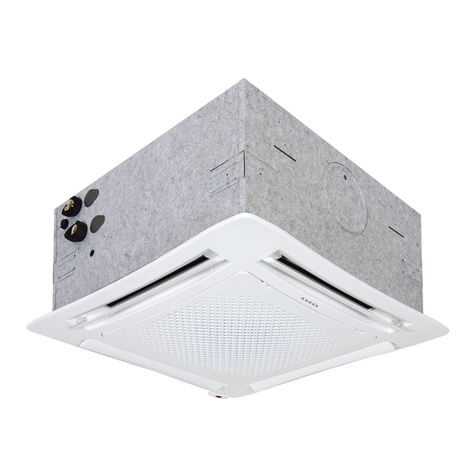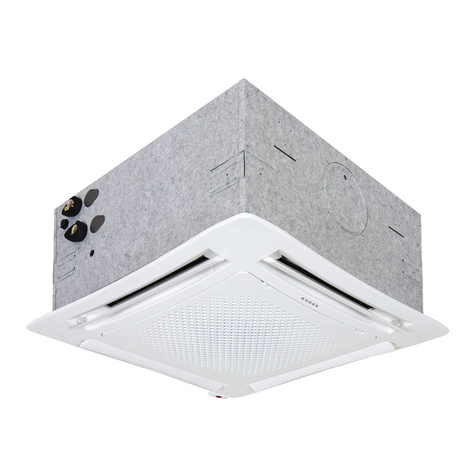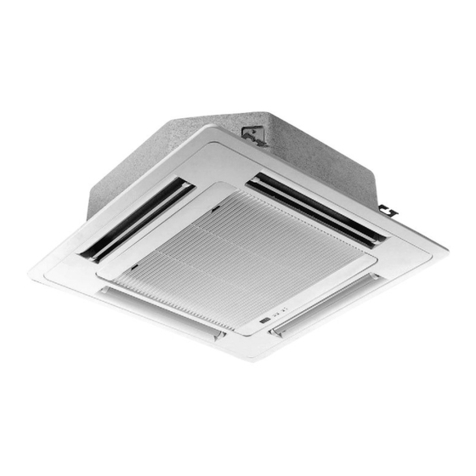
9
Sezione II :: Installazione e manutenzione IT
,¿OWULGHOO¶DULDVRQRLQ¿EUDODYDELOHFRQDFTXD/RVWDWRGLSX-
OL]LDGHL¿OWULGHYHHVVHUHFRQWUROODWRDOO¶LQL]LRGHOODVWDJLRQHGL
funzionamento e di norma mensilmente.
ƕ9HUL¿FDGHOORVWDWRGLSXOL]LDGHL¿OWULDULD
0DQXWHQ]LRQHRUGLQDULD
Mensile
A unità spenta, togliere il mantello della macchina e controllare
lo stato dello scambiatore e dello scarico condensa. Se neces-
sario:
ƕ9HUL¿FD GHOOR VWDWR GL SXOL]LD GHOOR VFDPELDWRUH H GHOOR
VFDULFRFRQGHQVD
Ogni 6 mesi
• DVSRUWDUH GDOOD VXSHU¿FLH DOHWWDWD TXDOVLDVL FRUSR HVWUDQHR
che possa ostruire il passaggio dell’aria;
• eliminare la polvere depositata mediante un getto d’aria com-
pressa;
• effettuare un blando lavaggio con acqua, unito ad un leggero
spazzolamento;
• effettuare l’asciugatura con aria compressa;
• controllare che lo scarico condensa non presenti ostruzioni
FKHSRVVDQRLPSHGLUHLOQRUPDOHGHÀXVVRGHOO¶DFTXD
ƕ9HUL¿FDGHOODSUHVHQ]DGLDULDQHOO¶LPSLDQWRDFTXD
1. Togliere il mantello della macchina;
2. avviare l’impianto per alcuni minuti;
3. fermare l’impianto;
4. DOOHQWDUHODYLWHGLV¿DWRVXOFROOHWWRUHG¶LQJUHVVRHV¿DWDUH
5. 5LSHWHUHO¶RSHUD]LRQHSLYROWH¿QRDTXDQGRQRQIXRULHVFH
più aria dall’impianto.
3HUHYLWDUHURWWXUHGRYXWHDOFRQJHODPHQWRDGRJQL¿QHVWDJLR-
ne è consigliabile scaricare l’acqua dell’impianto.
Se il circuito dell’acqua deve rimanere vuoto per più di un mese, l’intero
circuito va sottoposto a carica di azoto per evitare rischi di corrosione
per aerazione differenziale.
Per la manutenzione del circuito elettrico sono raccomandate
le seguenti operazioni:
ƕ6YXRWDPHQWRLPSLDQWRDFTXDSHUWXWWHOHEDWWHULH
$¿QHVWDJLRQH
&LUFXLWRHOHWWULFR
• YHUL¿FD GHOO¶DVVRUELPHQWR HOHWWULFR GHOO¶XQLWj PHGLDQWH SLQ]D
amperometrica e confronto del valore con quelli riportati sulla
documentazione.
• LVSH]LRQHHYHUL¿FD VHUUDJJLR FRQWDWWLHOHWWULFLH UHODWLYL PRU-
setti.
In caso di guasto del motore elettrico del ventilatore è necessa-
ria la sostituzione dell’intero gruppo ventilatore.
ƕ3HUULPXRYHUHLOYHQWLODWRUHVHJXLUHOHVHJXHQWLRSHUD]LRQL
0DQXWHQ]LRQHVWUDRUGLQDULD
6RVWLWX]LRQHGHOJUXSSRYHQWLODQWH
• Rimuovere il mantello;
• Scollegare il cavo elettrico di colle-
gamento del ventilatore;
• 5LPXRYHUH OH YLWL FKH ¿VVDQR LO
ventilatore alla struttura dell’unità
su entrambe i lati;
• Estrarre il ventilatore.
ƕ3HUULPXRYHUHORVFDPELDWRUHVHJXLUHOHVHJXHQWLRSHUD]LRQL
6RVWLWX]LRQHGHOORVFDPELDWRUH
• Rimuovere il mantello;
• Intercettare mandata e ri-
torno dell’acqua;
• Scollegare la batteria
dall’impianto;
• 5LPXRYHUHOHYLWLFKH¿VVD-
no la batteria alla struttura
dell’unità su entrambi i lati;
• Estrarre lo scambiatore.
• Se l’impianto è addizionato con liquido antigelo, quest’ultimo
non va scaricato liberamente, perché inquinante.
• Deve essere raccolto ed opportunamente smaltito;
• La componentistica elettronica (condensatori elettrolitici) è da
FRQVLGHUDUVL UL¿XWR VSHFLDOH FRPH WDOH YD FRQVHJQDWD DG XQ
ente autorizzato alla raccolta;
• Il materiale di isolamento dei tubi, in gomma poliuretanica
espansa, in polietilene espanso reticolato,in poliuretano espan-
so e la spugna fonoassorbente che riveste la pannellatura, de-
YRQRHVVHUHULPRVVLHWUDWWDWLFRPHUL¿XWLDVVLPLODELOLDJOLXUEDQL
• Non utilizzare ioni di ammonio NH4+ nell’acqua, sono molto nocivi per
il rame. Questo è uno dei fattori più importanti per la durata della vita
operativa dei tubi di rame. Un contenuto di varie decine di mg/l corro-
derà aggressivamente il rame nel tempo.
• Gli ioni di Cloruro Cl- sono nocivi per il rame con rischio di perforazioni
per corrosione o foratura. Se possibile mantenersi al di sotto dei 10
mg/l.
• Gli ioni di solfato SO4 2- possono causare corrosione perforante se il
loro contenuto è superiore ai 30 mg/l.
• 1RQXWLOL]]DUHLRQLGLÀXRUXURPJO
• Non devono essere presenti ioni Fe2+ e Fe3+ con livelli non trascurabili
GLRVVLJHQRGLVFLROWR)HUURGLVFLROWRPJOFRQRVVLJHQRGLVFLROWR
5 mg/l.
• Silicio disciolto: il silicio è un elemento acido dell’acqua e può anch’es-
VRFRPSRUWDUHULVFKLRGLFRUURVLRQH&RQWHQXWRPJO
• Durezza dell’acqua: > 0,5 mmol/l. Si consigliano valori compresi tra 1 e
2,5 Questo faciliterà la formazione di depositi calcarei in grado di limi-
tare la corrosione del rame. Valori troppo alti possono causare il blocco
dei tubi nel corso del tempo. È consigliabile un titolo alcalimetrico com-
pleto (TAC) inferiore a 100.
• Ossigeno disciolto: Evitare qualsiasi cambiamento improvviso delle
condizioni dell’ossigenazione dell’acqua. È nocivo sia deossigenare
l’acqua mischiandola con gas inerte che sovraossigenarla mischiando-
ODFRQRVVLJHQRSXUR8QDPRGL¿FDGHOOHFRQGL]LRQLGLRVVLJHQD]LRQH
dell’acqua favorisce la destabilizzazione dell’idrossido di rame e l’in-
grandimento delle particelle.
• 5HVLVWHQ]DVSHFL¿FDFRQGXWWLYLWjHOHWWULFDSLqDOWDODUHVLVWHQ]DVSH-
FL¿FDSLqEDVVDODWHQGHQ]DDOODFRUURVLRQH
• Si consigliano valori superiori ai 30 Ohm·m. Un ambiente neutro favo-
ULVFHYDORULGLUHVLVWHQ]DVSHFL¿FDPDVVLPL3HUODFRQGXWWLYLWjHOHWWULFD
si consigliano valori compresi tra 20 e 60 mS/m.
• S+&DVRLGHDOHGLS+QHXWURD&S+
,QGLFD]LRQLSHUORVPDQWHOODPHQWRGHOO¶XQLWjHVPDOWLPHQWR
VRVWDQ]HGDQQRVH
5DFFRPDQGD]LRQL5+266VXLÀXLGLGLVFDPELRWHUPLFR
Lo smantellamento dell’unità va eseguito solo da parte di ditta
autorizzata al ritiro di prodotti/macchine in obsolescenza.
La macchina nel suo complesso è costituita da materiali
trattabili come MPS (materia prima secondaria), con l’obbligo
di rispettare le prescrizioni seguenti:
SALVAGUARDIA AMBIENTALE
RHOSS da sempre è sensibile alla salvaguardia dell’ambiente.
E’ importante che le indicazioni seguenti vengano scrupolosamente
seguite da chi effettuerà lo smantellamento dell’unità
• Perrimontareloscambiatore operare inmanierainversa.
• Perrimontareilventilatore operare inmanierainversa.































